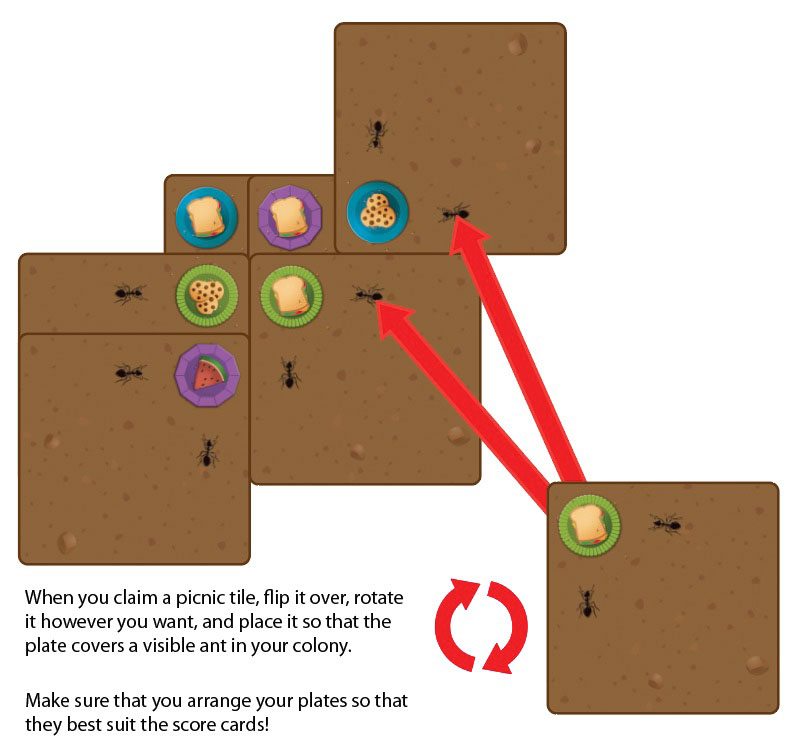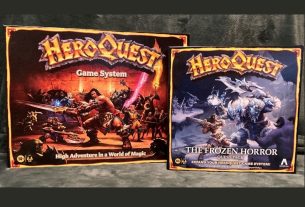Everyone loves a picnic—especially the ants! In Problem Picnic: Attack of the Ants, you’ll send out your teams of ants to bring back all of the tastiest foods for the Queen.
At a glance: Problem Picnic is a dice dexterity game for 2 to 4 players, ages 8 and up, and takes 20–30 minutes to play. It launched on Kickstarter today, with a $29CAD (~$22USD) pledge for a copy of the game. Problem Picnic was designed by Scott Almes with art by Josh Cappel, and is published by Kids Table Board Gaming. The game is a combination of rolling dice at particular targets and a puzzle aspect for scoring points, and I think the age recommendation seems about right. Younger players will probably enjoy the dice-rolling aspect but may not be as good at maximizing their scores.
New to Kickstarter? Check out our crowdfunding primer, and visit our curated page for more projects we love.

Components
- 54 Picnic cards
- 16 Scoring cards
- 6 Round cards
- 4 Anthill cards
- 1 Puddle card
- 24 Tie tokens
- 12 Rewards tokens
- 24 Ant dice
The ant dice are custom dice. Each player gets:
- 1 Soldier (12-sided)
- 3 Workers (6-sided)
- 2 Scouts (small 6-sided)
My review is based on a prototype so the component quality isn’t final and some features have already changed: for instance, tie tokens are now worth 3 points instead of 2 points, and the backs of the picnic cards look a little different now than in the prototype. However, the gameplay and most of the artwork will not change significantly from what I describe here.

The artwork on the picnic cards is cute: there are watermelons, sandwiches, and cookies on three different colors of plates (which also have different edges so they can be distinguished by color-blind players) on a checkered tablecloth or picnic blanket, and then the reverse side of the cards shows the same plate of food but on dirt, as if the ants have carried it away. I wasn’t thrilled with the anthill art, but it’s not a deal-breaker, either. There’s a very tiny flower in the corner of each anthill card for player color—these (and the dice) do not have any other distinguishing features, so I’m not sure how color-blind friendly that will be.

The dice themselves will be custom dice with the ants silkscreened onto them. (My prototype used stickered dice.) The 12-sided soldier dice have sides showing 1 or 2 ants. The 6-sided worker dice are more standard-size dice with faces showing 2, 3, and 4; the 6-sided scout dice are smaller and have faces showing 1, 2, 3. Both types of 6-sided dice have rounded corners, which makes them roll across the table a little better, but can also result in unpredictable wonky directions.

How to Play
The goal of the game is to score the most points by collecting plates from the picnic with your ants—the scoring will change each time you play, based on a random draw of the rewards tokens and the scoring cards.
To set up, you’ll lay out some picnic cards on the table in a particular pattern (dependent on the number of players). Each player gets all the ant dice of their color and an anthill card, which they place a card-length away from the picnic area. The puddle card is set to one side. The round cards are shuffled and a stack of 5 random round cards is set aside, with any remaining round cards put back in the box.
Finally, you set up the scoring cards. There’s one scoring card that shows the three foods and three colors—that one is always used, plus a set number of other scoring cards based on the player count. Each of the three foods and three colors gets a random rewards token placed on it, as does each of the other scoring cards.

Each round, players take turns rolling one die at a time from behind their anthill card into the picnic area, until everyone is out of dice. Once all the dice have been rolled, count up the number of ants each player has on each card—the most ants on a card wins, with ties broken by the player with the bigger die. (If it’s still a tie, nobody gets the card.)

The winner’s dice will go to the puddle (to be collected in the next round after dice are rolled) and everyone else on that card gets their dice back. Then the winner takes the picnic card and places it behind their anthill card, adding it to a grid of any existing cards. The picnic cards are refreshed, and another round will begin.
At the beginning of each round after the first, the player with the fewest collected picnic cards will go first that round and draws a round card—each one has a different special ability on it, which can be used during that player’s turn. When there are no more round cards to draw (after 6 rounds), the game is over.
Some of the dice have special powers: the Soldier die never goes to the puddle, even if it was used to capture a card. The Scout die may be re-rolled once if it does not land on a card on the first roll. The Worker dice don’t have a special ability, but it has the most ants on it for outnumbering other players.
At the end of the game, look at each rewards token and see who earned it: most of them award points to the player with the most of something: the most blue plates, the longest diagonal line of green plates, the most sandwiches, and so on. If there’s a tie for first, anyone who tied gets a 3-point tie token. Whoever has the most points wins!

The Verdict
Kids Table Board Gaming’s stated goal is to make kids’ games for adults—that is, games for adults that can also be played by kids (or vice versa). It’s run by the husband-and-wife team of Helaina and Josh Cappel, who are also parents themselves, and they know the pain of sitting through games designed for kids that don’t hold interest for adults, or games for adults that are much too complex for kids. Their first title, Foodfighters, was a duel between meats and vegetables and was funded on Kickstarter last year. Problem Picnic is their second venture, this time designed by the prolific Scott Almes.

Although the Kickstarter video focuses primarily on the kids enjoying the game, I will attest to enjoying this with adult friends, too. I really like dexterity games, and Problem Picnic is an interesting mix of strategy and physical skill. The randomized scoring cards are a nice way to mix things up, particularly the green scoring cards, because they offer different paths to victory. For instance, if sandwiches are worth 4 points each, but the player with the fewest sandwiches will get 6 points, you may wind up with some players going after a lot of sandwiches, and a few who just want to avoid them altogether. Likewise, there are some cards that award bonuses for particular arrangements of plates: the most sandwiches that aren’t touching each other, the most columns that each contain exactly 1 of each type of food, and so on. So when you’re collecting cards, the placement and arrangement of them can be a mini-puzzle. I really liked the mix of scoring cards and the way that they changed up the game each time we played.
Lest we forget, though, everything is dependent on your dexterity: it doesn’t matter what you’re planning if you can’t get your ants on the food. This is the part of the game that is both delightful and infuriating. Sure, everyone knows that you want that plate of purple cookies, and they will do everything they can to prevent you from getting it … but they might not have to. All of your dice might end up on the blue watermelon adjacent to it anyway. Or totally off the cards in some random corner of the table. Like many dexterity games, Problem Picnic requires a mix of skill and luck. Skill will let you knock an opponent’s die off a card, and maybe even land your die on the card you wanted. But, these being dice, you still may not end up with the right face showing once you get there. (If you have the skill to land your die on the right place and with the right face showing, then remind me not to play any dice games with you. Ever.)

The round cards are an interesting dual-purpose card. First, they track the number of rounds—when you run out of cards, the game is over. But they also serve as a bit of a catch-up mechanic, because the player with the fewest cards is the one who gets to draw one. (Or, in the case of a tie, the player with the fewest ant dice, and then a roll-off with the dice.) Each card gives the player a special ability that can be used once during the game. The Honey Spill pulls all the ants from up to two nearby cards on to itself—so you could use it to redirect some of your own ants onto a card you want, or redirect somebody else’s ants onto something you didn’t want. Bug Spray sends all the ants on a card home, and any ants that end up back on the Bug Spray card will go to the puddle. The Seagull just takes away two plates of food, so there are fewer cards available for that round. It’s a fun mix of one-time-use abilities.
The puddle is also a nice catch-up mechanic, since the player who took the most cards in a round will usually have the fewest dice available for the next round.
The theme itself got mixed reactions from my group (both adults and kids): some people liked it, and some didn’t care for it at all. Although I think the game could probably be re-skinned as something else, I’m fine with the theme as it is: ants are (so far) not an overdone theme, particularly grabbing food from a picnic.
Problem Picnic feels like it has a little bit of everything: dice, dexterity, strategy, and luck. I will warn you that if you aren’t a fan of dexterity games, this one may not be a good fit for you. But if you’re a fan of dexterity games and especially if you’re looking for a good game that adults and kids can play together, take a look at the Kickstarter page for more!





